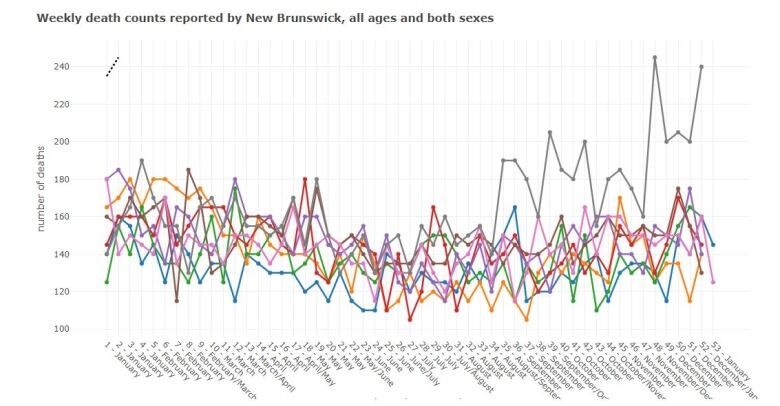Major revisions required in pandemic death counts a problem 'unique to New Brunswick'
Statistics Canada says low quality data from N.B. to likely trigger downward revision of excess deaths numbers

New Brunswick suffered the highest fatality rates in Canada in late 2021 and early 2022, according to ongoing estimates from Statistics Canada.
But the agency acknowledges it has been struggling with the accuracy of its New Brunswick pandemic death counts and is uncertain how reliable the province's shockinglyhigh numbers really are at the moment.
"I would imagine given past experience that we should see a revision to those and a downward revision as the estimates become more stable," said Owen Phillips, a senior analyst in Statistics Canada's Centre for Population Health Data.
"This is an issue unique to New Brunswick."
New and revised data released last week by Statistics Canada estimate 3,915 people died in New Brunswick over 20 weeks from August 29, 2021 to January 15, 2022. It is 859 more deaths (28.1 per cent) than normal for that time of year, even after adjusting for recent population growth.
On its face, the numbers paint an alarming picture of deaths piling up in the province through last fall and early winter at rates higher than those experienced by any other province and most U.S. states as the COVID-19 Deltavariant spread across the continent.

But three months ago, Statistics Canada was also reporting New Brunswick suffered a summertimerecord of 2,112 deaths over 13 weeks in June, July and August 2021. That was 279 more than normal for that time of year, an estimate theagency now says was overstated by 211.
All provinces have had initial death estimates from the summer of 2021 adjusted up and down by Statistics Canada to some extent in recent months but not by the hundreds like New Brunswick.
Death counts in June, July and August 2021 in Newfoundland and Labrador have been lowered by a total of five over the last three months. In Nova Scotia they have been lowered by two and in Saskatchewan they had to be raised by 24.
Statistics Canada says the need to lower death estimates from the same time period in New Brunswick by more than 200 is due to low-quality data it initially received from the province that has been causing problems with its own modelling.

"Our ability to provide timely and accurate data depends on our ability to get timely and accurate data from the provinces and territories," said Phillips.
"In New Brunswick, in an effort to increase the timeliness of their data, they increased the reporting of its more recent deaths, but providing this with less information. Ultimately the quality of these weekly adjusted counts is still largely contingent on the level of completeness of the data."
New Brunswick officially recorded 137 COVID-19 deaths between late August 2021 and early January 2022.
But if 859 more people died than normal in that period, it raises the possibility thatother issues may have been deadlier in combination with the pandemic than is generally understood. That would include things likebottlenecks in hospital emergency rooms, shortages of doctors and nurses. low testing rates or prematurely weakened public health protections.
Tara Moriarty an associate professor and infectious disease researcher at the University of Toronto,says understanding the seriousness of all of thoseissues is why death reporting from provinces needsto be quickand accurate during a pandemic and not subject to major revisions months after the fact.

"We need bloody faster reporting from provinces. It's ridiculous that we don't have this information in Canada when we need it.,' she said.
Moriarty believes current estimates that New Brunswick suffered high death counts through the fall and winter will hold up better than the 2021 summertime estimates did and will require the province to find the reasons why so many were killed.
"When the excess mortality numbers start getting big like they did in the fall, there's considerably less doubt at that point," said Moriarty.












_(720p).jpg)


 OFFICIAL HD MUSIC VIDEO.jpg)
.jpg)



























































































